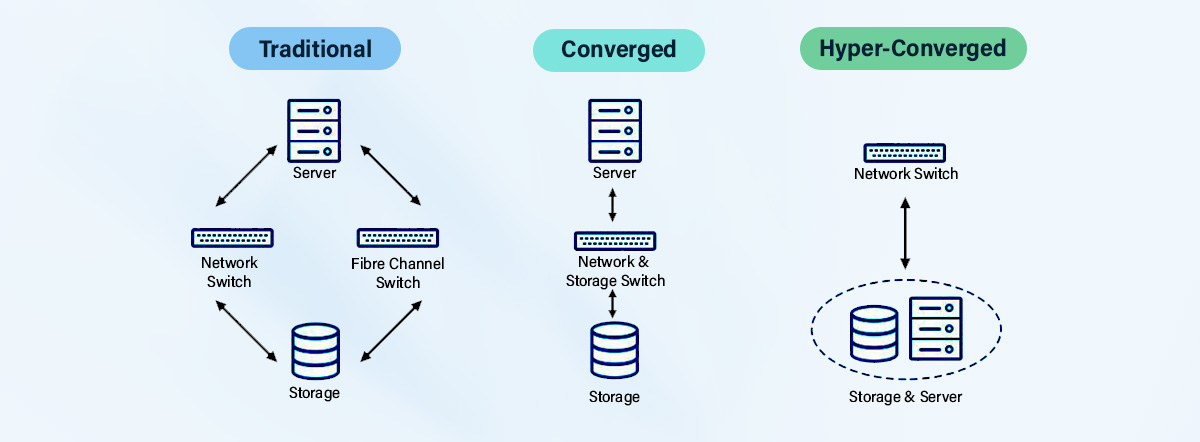
|
Getting your Trinity Audio player ready...
|
HCI Vs Traditional Infrastructure
Hyper-converged infrastructure (HCI) is a type of data center architecture that combines the three main components of a data center – compute, storage, and networking – into a single, integrated system. This allows for a more streamlined and simplified data center management, as all the resources are managed and configured from a single point.
One of the main benefits of HCI is that it can lead to lower costs and increased efficiency. By integrating all the resources into a single system, there is less need for specialized expertise and fewer components to manage and maintain. Additionally, HCI is often easier to scale, as it is designed to be more flexible and can support a wide range of workloads.
On the other hand, traditional data center architecture separates these resources into different components (such as servers, storage arrays, and network switches) that are managed independently. This allows for more control over individual components and can provide more options in terms of hardware and software vendors. This can be useful for larger organizations with specific requirements for their infrastructure and the need for more control over individual components.
When considering HCI versus traditional data center architecture, it is important to consider the specific needs of the organization. HCI is often a good choice for small to medium-sized organizations that want a simpler and more cost-effective data center solution. However, traditional data center architecture may be more suitable for larger organizations with specific requirements and the need for more control over individual components.
Another important aspect to consider is that HCI solutions are typically more software-centric, they rely heavily on software to provide the necessary virtualization and management, while traditional solutions tend to be more hardware-centric, using specialized hardware to provide dedicated resources and management. This can affect the level of control and customization that an organization has over their infrastructure.
There are several reasons why companies are increasingly adopting hyper-converged infrastructure (HCI) solutions:
Simplified management: HCI integrates compute, storage, and networking resources into a single system, which simplifies data center management by reducing the number of components that need to be managed and configured. This can lead to lower costs and increased efficiency.
Scalability: HCI is often easier to scale, as it is designed to be more flexible and can support a wide range of workloads. This allows companies to more easily adapt to changing business needs.
Lower costs: HCI can be more cost-effective than traditional data center architecture, as it eliminates the need for specialized expertise and hardware, and reduces the number of components that need to be maintained.
Flexibility: HCI allows companies to easily move workloads between different systems, making it easier to adapt to changing business needs.
Cloud readiness: HCI solutions are designed to be cloud-ready, which makes it easier for companies to move workloads to the cloud, and to implement hybrid cloud environments.
Improved performance: HCI solutions can improve performance by providing more efficient resource allocation, and by reducing the amount of data that needs to be moved between different systems.
Better disaster recovery: Some HCI solutions offer built-in disaster recovery capabilities, which can help companies to more easily recover from disasters.
Agile and fast deployment: HCI solutions are designed to be easy to deploy and configure, which means that companies can get up and running quickly, and can respond more quickly to changing business needs.
There are several disadvantages of traditional infrastructure compared to hyper-converged infrastructure (HCI):
Complex management: Traditional infrastructure separates compute, storage, and networking resources into different components, which can be more difficult to manage and configure. Costs can go up and productivity can go down as a result.
Limited scalability: Traditional infrastructure can be more difficult to scale, as it requires specialized expertise and hardware. This can make it more challenging to adapt to changing business needs.
Inflexibility: Traditional infrastructure can be less flexible, making it more difficult to move workloads between different systems and to adapt to changing business needs.
Limited cloud readiness: Traditional infrastructure can be more difficult to integrate with cloud environments, making it more challenging to move workloads to the cloud or to implement hybrid cloud environments.
Reduced performance: Traditional infrastructure can be less efficient, as it requires data to be moved between different systems, which can slow down performance.
Lack of built-in disaster recovery: Traditional infrastructure solutions do not often have built-in disaster recovery capabilities, which means that companies may need to rely on additional software and hardware to implement disaster recovery.
Lengthy deployment and configuration: Traditional infrastructure solutions can be complex to deploy and configure, which can delay the time it takes to get up and running and respond to changing business needs.
In summary
HCI and traditional data center architecture both have their advantages and disadvantages. Organizations should carefully consider their specific requirements and goals when deciding which approach to use.
HCI offers a number of benefits over traditional data center architecture, including simplified management, scalability, lower costs, flexibility, and cloud readiness. These benefits can help companies to more easily adapt to changing business needs and to improve their overall performance.
Traditional infrastructure has several disadvantages when compared to HCI. These include complex management, limited scalability, higher costs, inflexibility, limited cloud readiness, reduced performance, lack of built-in disaster recovery and lengthy deployment and configuration. HCI solutions can help to address these challenges and provide a more efficient and flexible data center solution.
Want to know how our solutions can help your business?